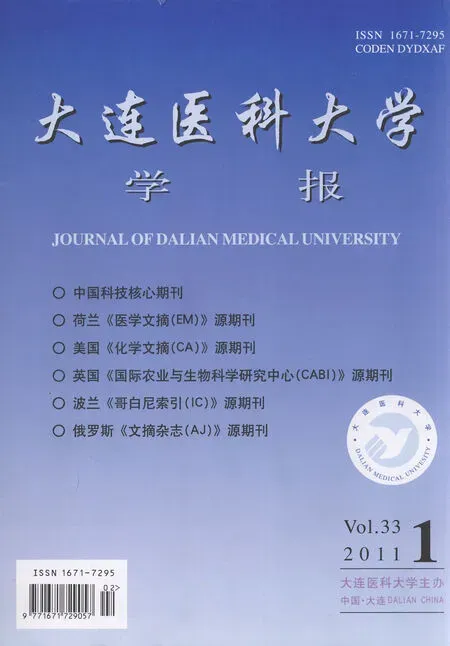E-cadherin-catenins粘附复合体与卵巢癌侵袭、转移和预后之间关系的研究进展
姜 琳,胡 军
(1.大连医科大学 2006级七年制,辽宁大连 116044;2.大连医科大学组织胚胎学教研室,辽宁大连 116044)
E-cadherin-catenins粘附复合体与卵巢癌侵袭、转移和预后之间关系的研究进展
姜 琳1,胡 军2
(1.大连医科大学 2006级七年制,辽宁大连 116044;2.大连医科大学组织胚胎学教研室,辽宁大连 116044)
卵巢癌是具有高度转移性的疾病而且是妇科恶性肿瘤的主要致死原因,对此病还没有很好的临床预测指标。E-cadherin-catenins粘附复合体在维持组织结构上起着重要作用,其异常表达与癌转移密切相关。本文对E-cadherin-catenins复合体在卵巢癌侵袭、转移及预后中所起的作用进行了综述。E-cadherin表达缺失或降低与卵巢癌组织分化低,侵袭、转移潜能强及预后差相关。
E-cadherin-catenins粘附复合体;卵巢癌;侵袭;转移;预后
1 概 述
卵巢癌是女性生殖器官中常见的肿瘤之一,发病率仅次于子宫颈癌和子宫体癌而列居第 3位。但是,卵巢癌致死率,却占各类妇科肿瘤的首位。卵巢癌临床早期无特别症状,如能早期诊断,可使患者的5年生存率从 25%左右上升到 90%以上[1,2]。
组织侵袭和转移是大多数侵袭性和致死性肿瘤的共同特征。肿瘤细胞失去识别和粘附于邻近细胞的能力,变得松动,从而侵入周围区域,进行转移,再进入到循环系统,外渗到达靶器官进行增殖。可见肿瘤细胞的脱离及粘附是转移的早期步骤,其复杂机制尚处于研究之中。上皮性钙粘附分子(E-cadherin)是与肿瘤早期的侵袭和转移关系比较密切的细胞粘附分子,它与细胞内四个连环蛋白(catenins)结合,进而与细胞骨架相连。这些分子整合起来就是 E-cadherin-catenins复合体,其结构、功能的异常改变与卵巢癌等许多肿瘤的去分化、侵袭力的增强、转移和生存率下降有关[3]。
2 E-cadherin-catenins粘附复合体
2.1 E-cadherin与catenins
E-cadherin也称为 uvomorulin、L-CAM、cell-CAM 120/80或 Arc-1,存在于从外胚层、中胚层、内胚层组织发育来的上皮细胞中,其编码基因位于染色体 16q22.1,蛋白分子量为 120 kD,是通过严格的Ca2+依赖方式来介导细胞间粘附作用的单个跨膜蛋白,主要分布于同种上皮细胞侧面的中间连接(粘着带)处,主要介导同质同嗜性粘附,即具有相同钙粘蛋白的细胞之间的粘附作用[4]。
介导细胞间粘附连接作用的 E-cadherin发挥其功能需要与一组细胞质分子 catenins的一系列复杂的相互作用,通过 catenins把 E-cadherin的细胞外区域连接到肌动蛋白的细胞骨架上,形成 E-cadherin-catenins粘附复合体。catenins由 αcatenin、β-catenin、γ-catenin和粘附调节分子catenin p120ctn组成。拥有最大程度同源性的 βcatenin和 γ-catenin通过互相排斥的方式直接连接到 E-cadherin位于细胞质内的尾端。然后 αcatenin连接到已经连接在细胞骨架的肌动蛋白网上的 β-catenin或者 γ-catenin上。p120的结构、在 E-cadherin的定位和配体与 β-catenin和 γcatenin大部分是相似的,但它不与肌动蛋白的细胞骨架连接[5],其作用和功能尚不完全清楚。
2.2 E-cadherin-catenins粘附复合体各组分的作用
E-cadherin及其每一个 catenin的功能和表达都正常是保证整个 E-cadherin-catenins粘附复合体完整和具有功能的关键。研究证明 E-cadherin在细胞粘附中有正调节作用:(1)细胞若不表达 E-cadherin则不能彼此聚集和粘附;(2)在细胞中,E-cadherin编码基因或 Ca2+的缺失都能引起细胞的分离;(3)将 E-cadherin cDNA转染入不表达 E-cadherin的细胞,可逆转细胞的不粘附状态;(4)E-cadherin功能障碍的细胞很容易通过淋巴管或静脉剪力把主要的肿瘤块冲掉[6]。同时有研究证明:(1)E-cadherin表达正常,但缺少任意一种 catenin表达的细胞也不能彼此聚集和粘附;(2)某种catenins编码基因的缺失和 catenins蛋白的突变都能导致细胞不能聚集和粘附;(3)E-cadherin与catenins在细胞内相互作用的区域突变会使细胞既不聚集也无粘附性[10]。这些结果指出,E-cadherin-catenins粘附复合体的侵袭抑制功能可能受复合体中不同组分的影响而发生改变,维持细胞的正常粘附需要 E-cadherin-catenins粘附复合体的完整性。现在研究已经证明,上述组成复合体蛋白质的表达在恶性肿瘤中普遍显示或多或少的异质性[7]。
3 E-cadherin-catenins粘附复合体与卵巢癌之间的关系
3.1 与卵巢癌细胞分化的关系
E-cadherin和 catenins表达发生改变与去分化有关。Elloul等[8]观察到与分化较好的卵巢癌相比,在适度或低分化的卵巢癌中 E-cadherin蛋白表达下降;与良性肿瘤相比,交界性及恶性卵巢癌中E-cadherin表达明显下调。在恶性肿瘤中,E-cadherin和 catenins在高分化的肿瘤中高表达,维持细胞的粘附性,降低侵袭性;反之,在低分化的肿瘤中,它们的表达减少,丧失细胞间的粘附作用并显示出高侵袭性行为,这增加了局部的侵袭、转移性疾病以及肿瘤的复发和预后不良等发生的危险性[9]。
研究发现,E-cadherin在卵巢癌发生发展中的作用呈复杂的时相性,在卵巢癌早期发生中,E-cadherin的高表达可能有促进卵巢上皮细胞恶性转化作用;此后,随着癌细胞的去分化程度增加,E-cadherin的表达水平逐渐下降,导致癌细胞间粘附功能丧失,进而从原发灶脱落,发生播散与转移;到达靶器官以后,又重新恢复表达 E-cadherin,继而在转移局部停泊、增殖。所以卵巢癌与其他类型的上皮性恶性肿瘤不同的是,在卵巢癌初期,为了上皮的去分化,E-cadherin的表达经常被获得;而在卵巢癌晚期,为了转移,E-cadherin的表达又被抑制[10,11]。
3.2 与卵巢癌的侵袭和转移的关系
E-cadherin在抑制肿瘤的侵袭中起关键性作用,特别是 E-cadherin的表达下降在卵巢癌转移中具有特异性[11]。研究证明,与原发固有的卵巢癌细胞相比,腹水中癌细胞的 E-cadherin表达下降。提示在卵巢癌晚期转移中,为了获得侵袭能力,E-cadherin的表达可能减少。而且在卵巢癌中,E-cadherin的丢失是一个频发事件,它促进癌细胞向腹膜的扩散[12]。作者的研究结果也显示 E-cadherin在人卵巢癌低转移细胞系中为高表达,在高转移细胞系中为低表达,差异具有显著性意义[13]。这些结果暗示着 E-cadherin可能是肿瘤侵袭的一个标志物。
免疫组化研究发现:在多数晚期上皮性卵巢癌的原发灶中,E-cadherin表达下调且不稳定,并认为这个下调是暂时的,可使癌细胞间连接松散,进而从原发灶脱离、侵袭和转移。卵巢癌转移灶中 E-cadherin表达低于原发灶;E-cadherin的表达在卵巢癌有淋巴结转移的肿瘤和无淋巴结转移的肿瘤中差异有显著性意义,伴有淋巴结转移者表达降低的几率大[14]。
也有学者对 catenin与卵巢癌的相关性进行了研究,提出在有转移的卵巢癌中 β-catenin表达下降[15]。还有研究发现 γ-catenin在转移灶中的表达高于原发灶,并可以作为卵巢癌高恶性程度和低生期的预测指标[16]。
3.3 与卵巢癌的预后的关系
有研究发现:与 E-cadherin正表达相比,E-cadherin负表达在预示低生存率上更有意义。也就是说,E-cadherin的低表达与卵巢癌预后不良有关[17]。Do TV等[14]实验证明,原发性卵巢癌由于E-cadherin表达不同而使患者的生存率有显著的差异。E-cadherin表达减少的患者生存率小于E-cadherin表达被保留的患者。而在转移灶中,E-cadherin表达不同的患者的生存率没有显著性差别。这表明在原发性卵巢癌中,E-cadherin表达的减少与总生存数的减少密切相关。而且 Faleiro-Rodrigues C[18]等在其实验的多变量分析中发现细胞减灭术后,E-cadherin负表达和肿瘤残留度对存活率来说是独立的预后因子。因此在卵巢癌中,判定 E-cadherin的表达情况可能是一个有用的预后指标。
3.4 E-cadherin与卵巢癌早期诊断
E-cadherin表达的丢失和减少在卵巢癌从良性向边缘性损害的转变过程中是一个发生较早的事件[19]。研究也证明 E-cadherin在正常的卵巢表面上皮几乎不表达,在高分化的恶性肿瘤中高表达;反之,在低分化的恶性肿瘤中低表达。而且 E-cadherin在卵巢癌转移灶中的表达明显低于原发灶,并且伴有淋巴结转移者表达降低的几率更大[13]。因此,检测出 E-cadherin低表达可能对鉴别临床上没有淋巴结转移而有隐藏转移风险的卵巢癌病人有用,并且可能对早期诊断有益。但 E-cadherin基因的点突变和部分缺失会使它的粘附功能丧失,而这并不影响它在免疫组化中的染色。另外,E-cadherin与 β-catenin复合物中酪氨酸的磷酸化也会抑制 E-cadherin的功能而不改变它的表达。所以目前还没有足够的证据证明检测 E-cadherin表达高低可以作为卵巢癌早期诊断的指标。
4 E-cadherin-catenins复合体:可否作为抗癌治疗的靶点
迄今为止,中晚期的卵巢癌被认为是很难治愈的,生存率很低。人们渴望寻求新的方法来控制这个疾病,目标是早期卵巢癌和个别高风险的癌前病变的化学预防。这暗示着未来卵巢癌化学预防的方向包括癌中的分子标记物的研究和分子靶向作用的实验研究。
E-cadherin-catenins复合体的多因子调节在特异靶器官治疗策略中具有重要意义。因为在恶性肿瘤细胞中,E-cadherin-catenins复合体的表达和功能经常下降,这就暗示着修复 E-cadherincatenins复合体将导致肿瘤细胞具有分化和抗侵袭的性质[20]。E-cadherin和 catenins的表达和功能可能在基因、转录和蛋白质水平上被调节。在卵巢癌中哪个是优势调节仍然不很清楚。体外实验将E-cadherin或 catenins编码基因转染入此基因产物不足的细胞中,结果显示细胞表现型从侵袭型转变成非侵袭型[21]。研究发现,胰岛素样生长因子Ⅰ通过与 E-cadherin相互作用抑制人乳腺癌细胞系的侵袭,但同时它也刺激了肿瘤的生长[22]。虽然细胞的生长和侵袭已经被证明是独立的,而且通过 E-cadherin-catenins复合体介导的生长和侵袭的效果也不同,但是主张用生长因子作为抗癌药去恢复E-cadherin-catenins复合体的表达看起来并不是恰当的。后来结果证明,癌蛋白 src刺激细胞生长并且降低细胞间粘附,而 Wnt信号传导系统刺激细胞生长同时稳定细胞间的粘附[23,24]。
通过多种多样的媒介物,在多种水平上可逆的或是永久的上调或下调 E-cadherin-catenins复合体的表达,多数实验支持该复合体有癌侵袭抑制因子的功能,经常在恶性肿瘤中下调表达。卵巢癌的临床研究数据已经证明这个复合体的表达降低与疾病的进展和生存时间的缩短有一定的关系。总之,在分子靶向治疗上 E-cadherin-catenins复合体备受瞩目,可能用来检测早期卵巢癌和更年期及绝经期高危度人群的癌前病变。
[1]Jemal A,Siegel R,Ward E,et al.Cancer statistics[J].CA Cancer JClin,2006,56(2):106.
[2]Naora H,Montell DJ.Ovarian cancermetastasis:integrating insights from disparatemodel organisms[J].Nat Rev Cancer,2005,5(5):355-366.
[3]Jeanes A,Gottardi CJ,Yap AS.Cadherins and cancer:how does cadherin dysfunction promote tumor progression?[J].Oncogene,2008,27(55):6920-6929.
[4]Al-Amoudi A,Diez DC,Betts MJ,etal.Themolecular architecture of cadherins in native epidermal desmosomes[J].Nature,2007,450(7171):832-837.
[5]Pokutta S,Weis WI.Structure and mechanism of cadherins and catenins in cell-cell contacts[J].Ann Rev Cell Develop Biol,2007,23:237-261.
[6]Shapiro L,William WI.Structure and biochemistry of cadherins and catenins[J].Cold Spring Harb Perspect Biol,2009,1(3):a003053.
[7]Gumbiner BM.Regu lation of cadherin-mediated adhesion in morphogenesis[J].Nat Rev Mol Cell Biol,2005,6(8):622-626.
[8]Elloul S,Vaksman O,Stavnes HT,et al.Mesenchymalto-epithelial transition determinants as characteristics of ovarian carcinoma effusions[J].Clin Exp Metastasis,2010,27(3):161-172.
[9]Wu C,Cipollone J,Maines-Bandiera S,et al.Themorphogenic function of E-cadherin-mediated adherens junctions in epithelial ovarian carcinoma formation and progression[J].Differentiation,2008,76(2):193-205.
[10]Gallo D,FerliniC,Scambia G.The epithelial-mesenchymal transition and theestrogen-signaling in ovarian cancer[J].Curr Drug Targets,2010,11(4):474-481.
[11]Kuwabara Y,Yamada T,Yamazaki K,et al.Establishment of an ovarian metastasismodel and possib le involvementof E-cadherin down-regulation in the metastasis[J].Cancer Sci,2008,99(10):1933-1939.
[12]Yuecheng Y,Hongmei L,Xiaoyan X.Clinical evaluation of E-cadherin expression and its regulation mechanism in epithelial ovarian cancer[J].Clin Exp Metastasis,2006,23(1):65-74.
[13]胡军,杨进,赵瑾瑶,等.人卵巢浆液性囊腺癌高低转移细胞株 E-cadherin差异表达[J].解剖科学进展,2006,12(3):209-211.
[14]Do TV,Kubba LA,Du H,et al.Transforming growth factor-beta1,transform ing growth factor-beta2,and transforming growth factor-beta3 enhance ovarian cancer metastatic potential by inducinga Smad3-dependent epithelial-to-mesenchymal transition[J].Mol Cancer Res,2008,6(5):695-705.
[15]StawerskiP,Wagrowska-DanilewiczM,StasikowskaO,et al.Immunoexpression of beta-catenin-E-cadherin comp lex in p rimary serous ovarian tumors[J].Pol J Pathol,2008,59(1):27-32.
[16]Davidson B,Gotlieb WH,Ben-Baruch G,et al.E-cadherin complex protein expression and survival in ovarian carcinoma[J].Gynecol Oncol,2000,79(3):362-371.
[17]Shim HS,Yoon BS,Cho NH.Prognostic significance of paired epithelial cell adhesion molecule and E-cadherin in ovarian serous carcinoma[J].Hum Pathol,2009,40(5):693-698.
[18]Faleiro-Rodrigues C,Macedo-Pinto I,Pereira D,et al.Prognostic value of E-cadherin immunoexp ression in patientswith p rimary ovarian carcinomas[J].Ann Oncol,2004,15(10):1535-1542.
[19]Ansenberger K,Zhuge Y,Lagman JA,et al.E-cadherin expression in ovarian cancer in the laying hen,Gallus domesticus,compared to human ovarian cancer[J].Gynecol Oncol,2009,113(3):362-369.
[20]Chu Q,Ling MT,Feng H,et al.A novel anticancer effect of garlic derivatives:inhibition of cancer cell invasion through restoration of E-cadherin expression[J].Carcinogenesis,2006,27(11):2180-2189.
[21]Ong A,Maines-bandiera SL,Roskelley CD,et al.An ovarian adenocarcinoma line derived from SV40/E-cadherin-transfected normalhuman ovarian surface epithelium[J].Int Jcancer,2000,85(3):430-437.
[22]Jones RA,Campbell CI,Wood GA,et al.Reversibility and recurrence of IGF-IR-induced mammary tumors[J].Oncogene,2009,28(21):2152-2162.
[23]Huveneers S,Arslan S,van deWater B,etal.Integrins uncoup le Src-induced morphological and oncogenic transformation[J].J Biol Chem,2008,283(19):13243-13251.
[24]Bryja V,Gradl D,Schambony A,et al.Beta-arrestin is a necessary component of Wnt/beta-catenin signaling in vitro and in vivo[J].Proc Natl Acad Sci USA,2007,104(16):6690-6695.
Research progress of the relationship between E-cadherin-catenins adhesion comp lex and the invasion,m etastasis,and prognosis o f ovarian cancer
JIANG Lin1,HU Jun2
(1.Grade 2006 of Seven-Year System,Dalian Medical University;2.Department of Histology and Embryology,Dalian Medical University,Dalian 116044,China)
Ovarian cancer is a highly metastatic disease and the leading cause of death from gynecologic malignancy.There are no good clinical predictors of this disease.E-cadherin-catenins adhesion complex p lays an important role inmaintaining tissue architecture.The abnormal expression of this com plex is associated with tumormetastasis.This review highlights recent progress in the effect of E-cadherin catenins complex on the invasion,metastasis,and prognosis of ovarian cancer.Loss or reduction of E-cadherin expression is related with poor histological differentiation,strong invasive and metastatic potential,and poor prognosis in ovarian cancer.
E-cadherin-catenins adhesion complex;ovarian cancer;invasion;metastasis;prognosis
R 737.3
A
1671-7295(2011)01-0078-04
辽宁省教育厅重点实验室项目(2008S079)
2010-09-15;
2010-11-02
姜琳(1986-),女,山东蓬莱人,七年制学生。E-jianglin4171299@sina.com
胡 军,教授,博士。 E-mail:hjshouyang@yahoo.com.cn

